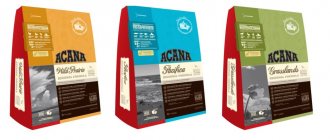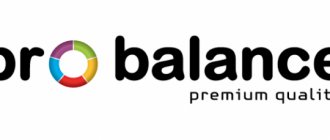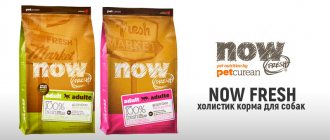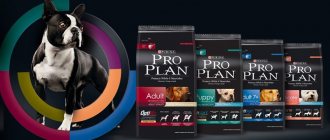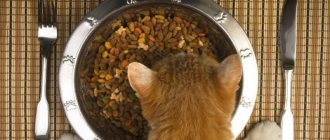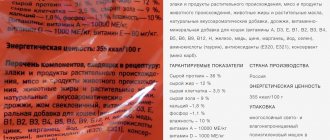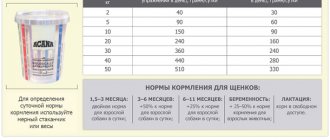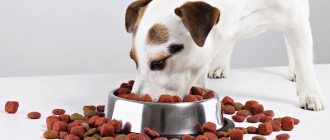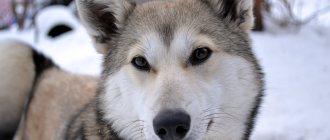Dry dog foods are quite convenient and beneficial for both owners and their pets, but meeting the internal vitamin and mineral needs of animals depends on several factors, and the quality of the product is often the most important. Most dry foods contain the optimal amount of proteins, fats and carbohydrates; they are divided by age, body size and other characteristics. Eating food also prevents the appearance of tartar, while the daily portion of food is already calculated by the manufacturer; you just need to adapt it to the weight of the pet. As for the owners, dry food stores well and does not require cooking. Of course, the quality of the feed and its composition play an important role. And the product class will help you find out how good a particular food is for your pet.
Economy class food
The most inexpensive and widespread category of feed is attractive, first of all, due to its price. They contain practically no meat. The entire meat part of the feed consists of offal and bone meal. The main percentage of the mass is occupied by plant components - soybeans, as well as wheat, corn and other grains. Such food will allow your pet to get enough, but as for the benefits, the effect will be very doubtful. They attract animals primarily due to flavors and enhancers.
List of feeds:
- Pedigree
- Cesar (Caesar)
- Chappi (Chappy)
- Darling
- Stout
- Our brand
- meal
Feed classification is outside the law
You should know that there is no officially accepted industry or any other legal classification of feed quality. Accordingly, there are simply no officially established standards and requirements, confirmed by scientific research, that diets must meet in order to be classified in one or another of the classes.
Rather, the process goes, so to speak, in reverse - this market-imposed gradation of feeds forces interested parties to identify the key distinguishing features of each class in order to understand how the feeds differ.
The current classification can be called the joint “oral creativity” of producers, sellers and buyers. Everyone, at their own discretion and depending on their own benefits or interests, classifies ready-made food as they want.
Class boundaries cannot be determined
We are faced with the fact that a lot of information about the classification of feed available to a wide audience, especially on the Internet, looks reasonable and clear at first glance, but is essentially a figment of the imagination of supporters of one class or another.
You should not believe those who write that “super premium” feed uses the highest quality raw materials, and “economy” feed uses the worst. No matter how much one would like to believe it, everything is far from so simple. There are no clear gradations, for example, between “economy” and “premium”, “premium” and “superpremium”, “superpremium” and “ultrapremium” feeds.
Premium class
This category includes feed containing up to 25-30% meat and offal. They are of higher quality than the previous class due to natural meat ingredients. The plant part of the product usually contains rice. These foods are well digestible, have a balanced composition and will undoubtedly benefit your pet. However, some products contain flavor enhancers. Therefore, food of a higher, super-premium class is recommended for puppies.
Premium feed rating:
- Royal Canin (Royal Canin) - the most popular
- Probalance
- Pro Plan
- Hills - second most popular
- Purina ONE (Purina van)
- Brit Premium
- Advance
- Nature's Protection
- Chicopee
Top 24 Dog Foods in 2021
The list of the best dog foods in 2021 included more than twenty options:
- Orijen;
- Piccolo;
- Acana;
- Applaws;
- Bozita;
- GO!;
- Grandorf;
- Wolfsblut;
- Schesir;
- Pronature;
- Berkley;
- Farmina;
- Natyka;
- Duke's Farm;
- Bosch;
- Four-legged gourmet;
- Brit Care;
- Arden Grange;
- 1st Choice;
- Hill's;
- Monge;
- Summit;
- Royal Canin;
- Pro Plan;
- Banters.
The rating update date is September 2021.
It is difficult to say unequivocally which dog food is the best. But many veterinarians and breeders note Hill's food, which includes wet canned food and dry food, belongs to the super-premium class. The price for an average package of 6.5 kg will be 2000 rubles (500 UAH). Although a lot depends on the composition, packaging option and line.
Super premium food
High quality feed that contains at least 25% natural meat and offal. This food is well absorbed by the dog’s digestive system and contains high quality products. The main symptom is the presence of exclusively meat in the food, without bone meal. By-products may also be present, but only of high quality and in clearly defined proportions. Also, the food often includes fish, selected grains and other healthy plant ingredients.
This category also produces specialized food for animals with certain health problems. This can be food for dogs with low immunity, diabetes and other diseases. Formulations are also produced for puppies, which veterinarians recommend using instead of premium products, not to mention economy ones. It does not contain any flavorings or artificial flavor enhancers.
List of super premium feeds
- 1st Choice (Fest Choice)
- Eukanuba (Eukanuba) - the most popular
- Schesir
- Josera
- Trainer (Trainer, Trainer)
- Gina (Gina Elite)
- Pronature Original
- Nutram
- Arden Grange
- Monge
- Dukes Farm
- Brit Care
- Barking Heads
- DailyDog
- Genesis Pure
Why are feeds divided into classes?
According to the current regulatory document: “Veterinary and sanitary standards and requirements for the quality of feed for non-productive animals,” dog food is divided into the following:
- Dry (5-12% moisture).
- Semi-moist (15 to 20% water).
- Canned (72-85% water).
- Frozen (60-70% water).
Division is carried out to confirm good quality. It will depend on him:
- Safety indicators.
- Shelf life.
- Conditions for optimal preservation.
Dry food looks like:
- Granule.
- Powdery.
- Flake-like.
- Cubes.
- Pills.
- Sticks.
- Cookies.
Canned as:
- Minced meat.
- Homogeneous mass.
- Whole pieces covered in sauce.
- Jelly.
Based on the level of nutrients and minerals, feed is divided into:
- Complete (dietary).
- Therapeutic.
- Extra treat.
Complete ones are divided into only 2 positions:
- For a growing organism and reproduction;
- For the physiological functioning of a sexually mature animal.
Note! Any other divisions are not provided for by certification bodies and are an “invention” of marketers.
The fact that manufacturers divide food for large, small, purebred and less purebred dogs has no legal or physiological basis.
Basic requirements for feed:
Safety
- No toxicity.
- Aflotoxins.
- Not exceeding the maximum permissible limits for heavy metals and pesticides.
- Compliance with microbiological indicators for general bacterial contamination, salmonella, E. coli, enterobacteria, toxin-forming anaerobes.
Nutritional Indicators
- Squirrels. These substances are a source of essential amino acids. The body cannot independently synthesize or store for future use. Therefore, they must enter the body in sufficient quantities every day. Amino acids are responsible for growth, development and reproduction, hormonal function and immunity, and maintain the body’s water balance. The source of protein is animal feed (meat, milk, eggs, fish). Synthetic amino acids are added to finished feeds, thereby balancing them according to this indicator. High-quality ones include processed meat and fish products.
- Fats. It is a source of energy and fat-soluble vitamins. Fat is part of the protoplasm of cells and its insufficiency in the diet disrupts the course of biochemical processes, causing pathology. The higher the physical activity and activity of the animal, the more saturated in fat the food should be. Fatty meats and fish, low-fat cottage cheese and whole milk can be sources of fat Fats of both plant and animal origin are added to finished feeds. Since fats tend to oxidize quickly, components that prevent oxidative processes are added to it.
- Carbohydrates. In low-quality feeds, this ingredient is the main one, since they consist of grains. In a dog's liver, carbohydrates (glucose, for example) are synthesized from proteins and fats, so carnivores do not need such substances. To determine the proportion of carbohydrates in the feed, it is enough to estimate the amount of fecal matter. If there are a lot of them and they are smelly, there are a lot of carbohydrates and the food is unsuitable for feeding dogs.
- Minerals. A dog's body requires more than 20 micro and macro elements every day. They are the basis of teeth and bones (phosphorus, calcium, magnesium), maintain hydrobalance in the body (sodium, chlorine, potassium, magnesium), and are part of the enzymatic and hematopoietic system (iron). Many minerals tend to accumulate in the body (heavy metals) and should therefore be monitored to ensure they do not exceed the maximum permissible level.
- Vitamins. They cannot be synthesized in the body, but some of them accumulate when taken in excess. The food contains both fat-soluble and water-soluble vitamins. Fat-soluble A, D, E, K are responsible for the condition of the skin and mucous membranes and the reproductive system. When formulating a recipe, these vitamins must be strictly standardized. Vitamins A and D accumulate in the body and can lead to irreversible pathology. Water-soluble vitamins are part of enzymes and many of them are not synthesized in the dog's body. Thus, a deficiency of B vitamins will lead to slower growth and development, dermatitis, and disorders of the nervous and cardiovascular systems.
A balanced amount of vitamins is the basis of good food, since a deficiency of some can lead to the inability to absorb others. If the food is of high quality, the dog does not need to be fed vitamin supplements.
Safety indicators are checked periodically at the manufacturer. Nutritional indicators are checked by a departmental laboratory (owned by the enterprise) or by agreement with any other.
Holistic food
The healthiest and highest quality dry food option for dogs of any age. Holistics contain a large amount of meat and do not contain by-products, not to mention bone meal and other substances. This category of food also includes natural sources of vitamins and microelements - fruits, vegetables and berries. All elements are perfectly balanced, the products are complete and contain all the substances necessary for the animal’s body. Of course, they are more expensive in price than all other categories of food, but this is justified by the undoubted benefits for your pet.
Holistic rating:
- Acana (Akana) - the most popular
- SAVARRA (Savara)
- Now Fresh (No Fresh) - second most popular
- Grandorf
- Orijen
- Canidae (Kanide)
- Applaws
- Go Natural holistic
- Summit
- ANF Holistic
- Holistic Blend
- Pronature Holistic
Holistic super premium class
As you can see, we classify “holistic” products as the “super premium” class, since, in our opinion, they are quite similar. We see no point in separating these diets into a separate class. First, let's explain where this name came from.
Translated from Greek, the word “holos” means “full”, “whole”, “harmonious”. There is a philosophical movement that considers the relationship between the human body, his spirit and the surrounding world as a single whole and considers this the path to the harmonious existence and improvement of man.
The holistic approach to medicine seeks not to treat, but to prevent disease through a healthy overall lifestyle, including a balanced diet. In the food industry, this complex philosophy has been transformed into the idea that an animal's diet should contain elements from a variety of food groups, and this supposedly guarantees the health of the pet.
In the USA, the first “holistic foods” appeared back in 1974, and the fashion for them reached Russia relatively recently. The number of “holistic” brands is small compared to other “super premium” foods.
“Holistic diets,” depending on the brand, can either be divided into products for different age groups and physiological conditions, or produced as single products for cats or dogs of any age, but at the same time differ in taste and composition. Let's talk in more detail about the features of these feeds.
Not all “holistics” are created equal
Some consumers mistakenly consider foods labeled “holistic” to be elite products. Whatever properties are attributed to them - hypoallergenicity, organic quality, naturalness, environmental friendliness, and the ideal composition of the formula, which supposedly gives the animal everything it needs for health in the correct proportions, and is perfectly absorbed.
We would not recommend unconditionally believing all such statements, understanding that each pet is individual. We will soon release an article about the essence of various marketing statements on food packaging that manufacturers use to attract customers, follow our publications!
The price of a package of “holistic” food is considerable, and, as a rule, much higher than the cost of the average “super premium” diet.
Composition of typical “holistics”
If you look at “holistic diets,” most of them contain grain and good meat and fish ingredients, and in a variety of proportions.
Typical “holistic products” seem to be balancing on the brink: on the one hand, they share the idea that dogs and cats need quality animal protein, and on the other hand, they do not refuse to add grain to their products, citing the fact that the animal should receive a full range of different products, that is, meat, grains, vegetables and fruits.
To be honest, this position in the spirit of “both yours and ours” seems somewhat strange to us. We are against grains in ready-made diets for carnivores, especially for cats, and as for vegetables and fruits, their images often look beautiful on the packaging, while the proportions of these components in the composition are negligible.
In addition, it is strange to say that a dog and a cat cannot live without bananas, papaya and various exotic spices - these are necessary components of the diet of monkeys and the chef's cupboard, but they are in no way suitable for carnivores.
Class "Biological compliance"
The category of so-called “biologically appropriate” - biologically appropriate feed - appeared on the Russian pet market relatively recently. This class of food arose on the basis of a deep understanding that a cat is an obligate predator, and a dog’s DNA is 99.8% identical to the DNA of a wolf, therefore they should not eat food waste or grain.
Manufacturers of these diets try, in the industrial production of dry food, to imitate the composition of products that cats and dogs could receive while living in the wild.
Better quality raw materials
The main distinguishing feature of such food is its very high, about 70%, content of high-quality meat, poultry and fish, that is, sources of high-quality animal protein and fat.
In many of these feeds, grains are kept to a minimum (contained only due to the technological necessity of production) or even completely absent, and some of the necessary carbohydrates are supplied to the feed by legumes and potatoes. In the composition of these diets, one can also note the presence of fresh and raw meat and fish components.
If you evaluate the raw materials in such diets, then they are of much higher quality than in feeds of other classes, and what is important is that they are indicated clearly, in as much detail as possible (and not in general words and groups). Some “holistic” diets are somewhat similar to these products, but as a rule, there are significantly fewer meat ingredients.
Packaging designs for both “holistic” and “biologically appropriate” products often reflect nature motifs and subdued colors.
In general, we share this “natural” concept of nutrition for dogs and cats. True, as in “holistic” foods, “biologically appropriate” diets contain various herbs, vegetables, fruits and spices - we tend to consider them rather as an additional reason to talk about the product, since small amounts of these ingredients can serve only which are sources of fiber.
Wet food
A separate type of feed, produced in the form of pates, canned food and pouches. The meat content may vary and you should carefully read the label. Canned foods contain the most meat; this can even be determined visually by looking at the product in an open can. Wet food contains grains, fish, organ meats, as well as vegetables and other sources of vitamins. The quality and percentage composition depends on the class. Like dry foods, wet dog foods are divided into economy, premium and super-premium. The content of meat, offal and other useful substances is approximately the same.
List of basic wet food:
- Economy class - Chappi, Pedigree, Cesar, Happy Dog, Darling, I eat without problems;
- Premium class - Hills, Purina Pro Plan, Dr. ALDER's, Royal Canin, Brit Premium;
- Super-premium food - Arden Grange, Eukanuba, Animonda, Berkley, Almo Nature.
Types of feed
Depending on the appearance and method of production, dry and wet food and canned food are distinguished. Most dog owners buy dry food, but they still need to monitor their pet’s water balance. Wet canned food is often purchased for puppies or to diversify their diet.
Dry food
Dry food is a nutritious diet in the form of pressed kibble of different sizes, produced taking into account the needs of the dog. In the best options, food contains more protein, a minimum of carbohydrates and animal fats. The basis of any croquettes is meat, it is better when it is natural. Cereals, eggs, dry vegetables and extracts, mineral complexes are also added. Food is produced using ovens, high temperatures, and sometimes freezing at low temperatures.
Super-premium croquettes are steamed to preserve vitamins and nutritional components. You can give dry food from two months of life, after weaning from mother's milk. But for this it is better to choose a special ruler. The best options for dry food are Eukanuba, Acana, and Orijen.
It is important that dry food can be soaked in water or given in its natural form. The main thing is to monitor the amount of water in relation to the portion of croquettes.
Canned food
Wet food consists of 75% moisture, is more nutritious, and therefore costs more than dry food. When making such food, all components are mixed, then a special component is added to maintain moisture, after which the product is heat treated at lower temperatures than dry.
Canned dog food is less popular than dry food. Because many experts do not recommend canned food as the basis of the daily diet. This is dictated by the fact that wet canned food loses some of its nutritional properties due to the large amount of moisture. Canned food from Purina Pro Plan, Eukanuba, and Happy Dog are especially recommended. The main components of canned food are fresh meat, vegetables, eggs and potatoes with broth and sauce.
Wet nutrition can be divided into two types:
- gourmet food acts as a delicacy; it contains a lot of fruits, vegetables, and medicinal herbs, but the nutrition is not balanced. These canned foods are given to diversify the diet, not constantly or in small portions;
- Medicinal foods are prescribed by a veterinarian for the treatment and prevention of certain types of diseases. It is important to adhere to the dosage and give only high quality canned food.
By the way, when buying canned food in a jar or bag, keep an eye on the tightness, expiration date, and condition of the packaging (no swelling, no leaks). Choose options based on your pet's age.
What is economy class dry food?
Since this category of food is the most popular, it is worth understanding it in more detail.
The composition of such feeds includes by-products of the 4th class. This suggests that in such mixtures the manufacturer can absolutely safely use the meat of sick animals. Of course, there is nothing good in this, since such a product may contain dangerous pathogens. Such nutrition can even lead to the formation of a tumor in the body of the unfortunate animal. In addition, the composition of such feeds quite often includes meat from livestock that was raised using antibiotics and rather aggressive growth hormones. The fact is that even after high-quality heat treatment, these components still remain unchanged.
However, it would be fair to say that economy-class dry food contains a regulated amount of vitamins and some nutrients. In addition, compositions of this type contain the required amount of protein and fat, which is necessary for the full functioning of the body of your beloved pet.
Chemicals such as propyl gallate act as preservatives here. When it comes to dyes and flavor enhancers, these are most often synthetic rather than natural substances. Such components can trigger an allergic reaction. Also, concentrated salts are often used in such feeds. Such additives certainly give the food a delicious aroma, so animals begin to eat it with great eagerness.
"Economy"
Among the dog foods in this segment, it is worth highlighting several foods:
- Darling;
- Chappi;
- Pedigree;
- "Our Brand"
The main advantage of this class of food is that it costs much less than its analogues. Of course, the cost 3-4 times lower captivates animal owners.
However, you need to understand that such a low price is due to the poorest quality of the original products. Accordingly, such dog food contains practically no nutritional or other beneficial components that the animal’s body needs. Also, such a diet lacks natural ingredients (for example, protein). Most often, the main component of this type of feed is cereals. They are much cheaper than natural meat. Therefore, by and large, such nutrition is a “dummy”.
How the diet is selected
There are several rules that will help you make the right choice. To do this you need:
- Consult a veterinarian and find out which food is suitable for a particular dog. When choosing food, the age, breed, weight and other characteristics of the animal must be taken into account. In addition, the doctor will be able to tell which ailments the pet is predisposed to. All this information will help you create the most suitable diet and decide on the best brand of food. In addition, the doctor can tell whether the pet has a tendency to allergic reactions.
- Carefully study reviews on the Internet. Two Meat dog food is sometimes more popular than similar food from other manufacturers.
- Familiarize yourself with the composition of various feeds. If meat flour is listed first on the list, then it is better to abandon this option. The first ingredient should be natural meat (for example, chicken or beef). Also, dog food must be free of dyes, preservatives, thickeners and other chemical additives. A conscientious manufacturer will never use such components when preparing food for four-legged pets. The more natural ingredients in the food, the better.
Don't assume that cheaper food is the worst. In fact, some new manufacturers, trying to win over their customers, offer a pretty good product. In addition, there is always an exception to any rule. Therefore, you should not discount cheaper types of dog food. Premium and super-premium mixtures are widely popular due to the large selection of different types of nutrition. In addition, renowned manufacturers prefer to adhere to the best power manufacturing technology.
Today there are a huge number of types of dog food on the pet market. Therefore, it becomes very difficult for a novice animal owner to make a choice in favor of one food or another.
To simplify the choice, you need to remember that all food is divided into 4 categories of classes, each of which is worth considering in more detail.
Premium dry dog food
All food croquettes are very similar to each other, but their composition can vary greatly. What is the best dog food? The one that has the most balanced, healthy composition does not cause digestive disorders, allergies or other troubles in the pet and at the same time the pet likes it. Premium mixtures are richer and healthier in composition than economical feeds.
The meat components used here are offal, inexpensive varieties of white fish and mechanically separated poultry. It contains more animal proteins; to improve digestion, vegetables, healthy vegetable oils and certain vitamins are included in the food. However, the basis of croquettes remains cereals, such as corn, wheat, oats or rice.
In order for the animal to feel good, healthy and vigorous, its diet is supplemented with vitamins, bioactive substances that improve digestion and care for the coat.
If your pet is prone to food allergies, it is better to choose a hypoallergenic dog food with a low content of grains, turkey or duck, the meat of which rarely causes unwanted reactions.
